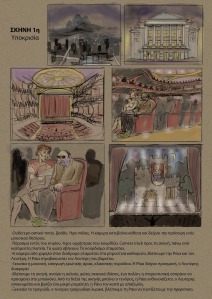Perfectionism, in
psychology, is a
personality disposition characterized by an individual striving for flawlessness and setting excessively high performance standards, accompanied by overly critical self-evaluations and concerns regarding others’ evaluations.
[1][2] It is best conceptualized as a multidimensional characteristic, as psychologists agree that there are many positive and negative aspects.
[3] In its
maladaptive form, perfectionism drives individuals to attempt to achieve an unattainable ideal, and their
adaptive perfectionism can sometimes motivate them to reach their goals. In the end, they derive pleasure from doing so. When perfectionists do not reach their goals, they often fall into
depression.
[edit]Definition
Perfectionists have also been described as those who strain compulsively and unceasingly toward unobtainable goals, and who measure their self-worth with their productivity and accomplishment.
[4] Pressuring oneself to achieve such unrealistic goals inevitably sets the individual up for disappointment. Perfectionists tend to be harsh critics of themselves when they do not meet the standards they set for themselves.
[edit]Normal vs. neurotic perfectionists
Hamachek was one of the first psychologists to argue for two distinct types of perfectionism, classifying people as
normal perfectionists or
neurotic perfectionists. Normal perfectionists pursue perfection without compromising their self-esteem, and derive pleasure from their efforts. Neurotic perfectionists strive for unrealistic goals and consistently feel dissatisfied when they cannot reach them.
[5] Today researchers largely agree that these two basic types of perfectionism are distinct.
[6] They have been labeled differently, and are sometimes referred to as positive striving and maladaptive evaluation concerns, active and passive perfectionism, positive and negative perfectionism, and adaptive and maladaptive perfectionism.
[7] Although there is a general perfectionism that affects all realms of life, some researchers contend that levels of perfectionism are significantly different across different domains (i.e. work, academic, sport, interpersonal relationships, home life).
[3][edit]Perfectionistic strivings vs. perfectionistic concerns
Stoeber and Otto (2006) stated that perfectionism consisted of two main dimensions:
perfectionistic strivings and
perfectionistic concerns.
[7] Perfectionistic strivings are associated with positive aspects of perfectionism, whereas perfectionistic concerns are associated with negative aspects (see below). Healthy perfectionists yielded high scores in perfectionistic strivings and low in perfectionistic concerns, whereas unhealthy perfectionists yielded high scores in both strivings and concerns.
[7] As expected, non-perfectionists demonstrated low levels of perfectionistic strivings.
[7] Prompted by earlier research providing empirical evidence that perfectionism could be associated with positive aspects (specifically perfectionistic strivings),
[8] they challenged the widespread belief that perfectionism is only detrimental. In fact, people with high levels of perfectionistic strivings and low levels of perfectionist concerns demonstrated more self-esteem, agreeableness, academic success, and social interaction.
[7] This type of perfectionist also showed fewer psychological and somatic issues typically associated with perfectionism, namely depression, anxiety, and maladaptive coping styles.
[7]Perfectionism has also been defined as a unitary combination of a desire to be perfect, a fear of imperfection, and an emotional conviction that perfection (not “near-perfection”) is the only route to personal acceptance by others.
[9] Perfectionism itself is thus never seen as healthy or adaptive.
[9] Greenspon also makes a distinction between perfectionism and striving for excellence.
[9][10][11][12] The difference is in the meaning given to mistakes. Those who strive—however intently—for excellence can simply take mistakes (imperfections) as incentive to work harder. Unhealthy perfectionists consider their mistakes a sign of personal defects. For these individuals, anxiety about potential
failure is the reason perfectionism is felt as a burden.
[edit]Measurement
[edit]Multidimensional Perfectionism Scale (MPS)
Hewitt & Flett (1991) devised the
Multidimensional Perfectionism Scale (MPS), a 45-item measure that rates three aspects of perfectionistic self-presentation: self-oriented perfectionism, other-oriented perfectionism, and socially prescribed perfectionism.
[13] Self-oriented perfectionism is having irrational expectations and standards for oneself that lead to a perfectionistic motivation.
[14] An example is the constant desire to achieve an ideal physical appearance out of vanity. Other-oriented perfectionism is having irrational expectations and standards for others that in turn pressure them to have perfectionistic motivations of their own. Socially prescribed perfectionism is developing perfectionistic motivations due to the belief that significant others expect them to be perfect. Parents that push their children to be successful in certain endeavors (such as athletics or academics) provide an example of this type of perfectionism, as the children feel that they must meet their parents’ lofty expectations.
[edit]Almost Perfect Scale-Revised (APS-R)
Slaney and his colleagues (1996) developed the
Almost Perfect Scale-Revised (APS-R) to identify perfectionists (adaptive or maladaptive) and non-perfectionists.
[15] People are classified based on their scores for High Standards, Order, and Discrepancy measures. Both adaptive and maladaptive perfectionists rate highly in High Standards and Order, but maladaptive perfectionists also rate highly in Discrepancy. Discrepancy refers to the belief that personal high standards are not being met, which is the defining negative aspect of perfectionism.
[15]Maladaptive perfectionists typically yield the highest social stress and anxiety scores, reflecting their feelings of inadequacy and low self-esteem.
[6] In general, the APS-R is a relatively easy instrument to administer, and can be used to identify perfectionist adolescents as well as adults, though it has yet to be proven useful for children.
[6] Interestingly, in one study evaluating APS-R in an adolescent population, maladaptive perfectionists obtained higher satisfaction scores than non-perfectionists. This finding suggests that adolescents’ high standards may protect them from challenges to personal satisfaction when their standards are not met.
[6] Two other forms of the APS-R measure perfectionism directed towards intimate partners (Dyadic Almost Perfect Scale) and perceived perfectionism from one’s family (Family Almost Perfect Scale).
[edit]Physical Appearance Perfectionism Scale (PAPS)
The
Physical Appearance Perfectionism Scale (PAPS) explains a particular type of perfectionism – the desire for a perfect physical appearance.
[3] The PAPS is a multidimensional assessment of physical appearance perfectionism that provides the most insight when the sub-scales are evaluated separately.
[3] In general, the PAPS allows researchers to determine participants’ body image and self-conceptions of their looks, which is critical in present times when so much attention is paid to attractiveness and obtaining the ideal appearance.
[3] The two sub-scales it uses to assess appearance concerns are Worry About Imperfection and Hope For Perfection. Those that obtain high Worry About Imperfection scores are usually greatly concerned with maladaptive aspects of perfectionism, physical appearance, and body control behavior.
[3] They also demonstrate low positive self-perceptions of their appearance, whereas those scoring highly on Hope for Perfection yielded high positive self-perceptions.
[3] Hope For Perfection also corresponded with impression management behaviors and striving for ambitious goals. In sum, Worry About Imperfection relates to negative aspects of appearance perfectionism, while Hope For Perfection relates to positive aspects. One limitation of using the PAPS is the lack of psychological literature evaluating its validity.
[3][edit]Psychological implications
Daniels & Price (2000) refer to
perfectionists as “
ones“.
Perfectionists are focused on personal integrity and can be wise, discerning and inspiring in their quest for the truth. They also tend to dissociate themselves from their flaws or what they believe are flaws (such as negative emotions) and can become
hypocritical and
hypercritical of others, seeking the illusion of virtue to hide their own vices.
[16]Perfectionism can be associated with various mental disorders, particularly
depression,
anxiety,
OCD, and
eating disorders. However, each disorder has varying levels of the three measurements.
[14] Socially prescribed perfectionism in young women has been associated with greater body-image dissatisfaction and avoidance of social situations that focus on weight and physical appearance.
[17]The book “Too Perfect: When Being in Control Gets Out of Control” by Jeanette Dewyze and Allan Mallinger contends that perfectionists have obsessive personality types.
[18] Obsessive personality type is different from
obsessive-compulsive disorder (OCD) in that OCD is a clinical disorder that may be associated with specific ritualized behavior. According to Mallinger and DeWyze, perfectionists are obsessives who need to feel in control at all times to protect themselves and ensure their own safety. By always being vigilant and trying extremely hard, they can ensure that they not only fail to disappoint or are beyond reproach but that they can protect against unforeseen issues caused by their environment. Vigilance refers to constant monitoring, often of the news, weather, and financial markets.
[18][edit]Positive aspects
Perfectionism can drive people to accomplishments and provide the motivation to persevere in the face of discouragement and obstacles. Roedell (1984) argues:
“In a positive form, perfectionism can provide the driving energy which leads to great achievement. The meticulous attention to detail, necessary for scientific investigation, the commitment which pushes composers to keep working until the music realises the glorious sounds playing in the imagination, and the persistence which keeps great artists at their easels until their creation matches their conception all result from perfectionism.”
[19]
Slaney and his colleagues found that adaptive perfectionists had lower levels of procrastination than non-perfectionists. In the field of
positive psychology, an adaptive and healthy variation of perfectionism is referred to as
Optimalism.
[20]Exceptionally talented individuals who excel in their field sometimes show signs of perfectionism. High-achieving athletes, scientists, and artists often show signs of perfectionism. For example, some contend that
Michelangelo‘s perfectionism may have motivated him to painstakingly complete his masterpieces including the statue
David and the
Sistine Chapel. Scientists that intently pursue their interests in the laboratory are often considered perfectionists. This obsession with an end result may motivate them to work diligently and maintain an impressive work ethic. Famous figures have publicly admitted that they have perfectionist tendencies.
Martha Stewart once described herself to Oprah Winfrey as a “maniacal perfectionist.”
[21] An intense focus on one’s passion can lead to success.
The adaptive form of perfectionism is typically considered the positive component of this personality trait. Adaptive perfectionism includes preferences for order and organization, a persistent strive for excellence, and conscientious orientation to tasks and performance.
[22] All of these characteristics are accompanied by low criticism and negativity, and high support and self-esteem.
[22] The positive, adaptive forms of perfectionism are more closely associated with the Big Five personality factor of
Conscientiousness, whereas maladaptive forms are more similar to
Neuroticism (see below).
[22][edit]Negative aspects
In its pathological form, perfectionism can be damaging. It can take the form of
procrastination when used to postpone tasks and
self-deprecation when used to excuse poor performance or to seek sympathy and affirmation from other people. In general, maladaptive perfectionists feel constant pressure to meet their high standards, which creates cognitive dissonance when one cannot meet their own expectations. Perfectionism has been associated with numerous other psychological and physiological complications as well.
Author Hillary Rettig has identified more than a dozen characteristics of perfectionists, including:
[23]
- Grandiosity – The deluded idea that things that are difficult for other people should be easy for you.
- Focus on Product over Process – Neglecting the journey of work while fixating on the outcome.
- Focus on External Rewards over Internal Ones
- Deprecation of the True Processes of Creativity and Career-Building
- Labeling – Harshly branding oneself with terms like stupid, lazy, wimpy, etc.
- Hyperbole – Overstating the negative.



























